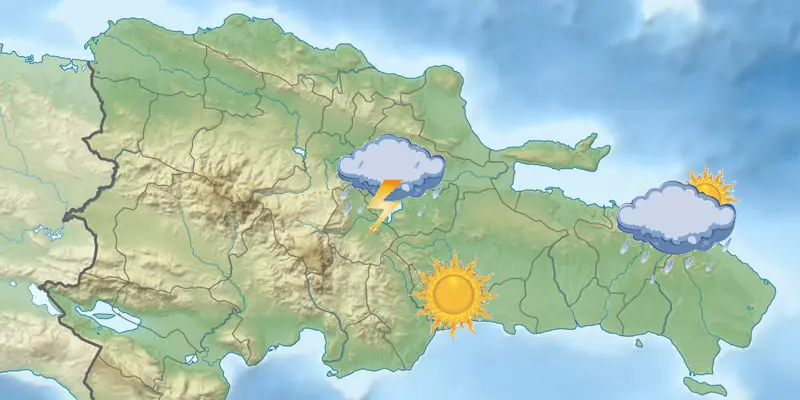[ssboost]
Weather in the Dominican Republic and the Caribbean is basically temperate and mild year round, save for the rare tropical storm or hurricane. For at least 300 days out of the year, the forecast is usually at least partly sunny or partly cloudy, with possibilities of a short rain shower. Rain usually occurs mostly at either sunrise, late afternoon, or at night. Since sun is the predominate weather throughout the day be sure to bring sun block and some type of head covering or hat for protection in the sun.
What time of year does it rain less?
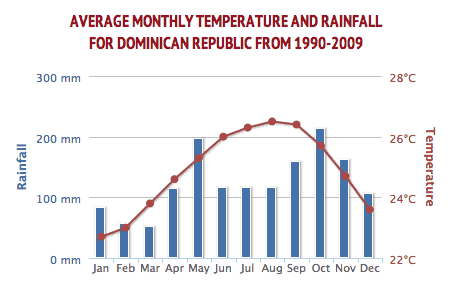
Concerns about the weather throughout the year in the Caribbean should not be the most deciding factor on your choice of visitation time. More importance should be placed on forecasts of an extremely hot summer or unusually cold winter.
The reason for this is that the weather in the Dominican Republic varies only slightly year round, so basing a vacation based on the least rainy season should be considered only slightly important.
December – April
These months are the coolest out of the season. Temperatures may hit a low of 18ºC (66ºF) on some mornings, especially in February. One can expect afternoon temperatures of around 28ºC (83ºF). When traveling during these months a light jacket or thin sweater may come in handy. Also, nighttimes in Punta Cana and the East coast can be very windy during this time.
March – April
These months in the Dominican Republic are breezy and windy, good for kite flying. Kites are actually sold on some of the major roads during holiday time at Easter.
May – June
May and June are known to be the rainiest months. However, in recent years, El Niño and La Niña have changed the weather patterns, so the nationwide weather forecast remains partly cloudy/partly sunny, with chances of a brief shower. Still, it is more likely to rain afternoons than in mornings.
August – September
This is the high point of hurricane season, which goes from June 1st through November 30th in the Caribbean. Hurricanes in June/July are rare, when waters are not warm enough to create hurricane conditions. The two hottest months out of the year are August and September, when temperatures hit 32-34ºC (90-94ºF). These are the months travelers should be most concerned about for extreme heat and hurricane watches, but overall, weather in the Dominican Republic and surrounding Caribbean is known to be very mild.
October – November
These also used to be the wettest months out of the year but again, weather patterns have changed. Caribbean rainstorms usually only last five minutes or less and the sun comes out again shortly after. So if it rains, don’t be discouraged as most likely the storm will end within a few minutes or less than an hour. Most Dominicans own umbrellas but the majority of them do not own raincoats for this reason.
Do temperatures on the beach vary?
There is only a very slight change in water temperature in the Caribbean year round. Unless a cold front hits the area, average island temperatures stay around 26-27ºC (80-82ºF). Usually Dominicans visit the beach less from November to Easter week in April, but warmer temperatures have been the norm in recent years so beach season has been extended year round.
Which coast has the best weather?
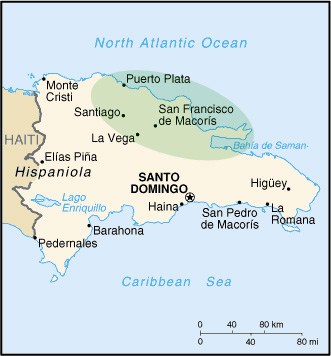
The Dominican Republic is fairly large, so it can be raining on one coast while the sun shines on another. The driest section is the Southwest area of Barahona, Bani and Azua.
The southeastern and eastern coasts of Boca Chica, Juan Dolio, La Romana (Bayahibe) and Punta Cana follow next.
Samana is the wettest part of the country along with Puerto Plata. However, being that they’re wet means they’re also very lush and tropical and have a very natural beauty.
If you visit Puerto Plata or Samana during Christmas or New Year’s, there’s a 40% chance it could rain for a few days.
The good news is that Puerto Plata has never had a hurricane, and the tropical rains are warm and a stroll through the warm rains is always a romantic idea.
What are the chances my trip will be rained out?
Chances are very slim that a trip to the Dominican Republic will be a complete rain out. Staying for a week would give you chances of at the very least four good days out of seven, because it rains that little. If there is a shower, it will only last a few minutes or a very short time.
The only exception in this case is if there is a tropical storm or wave. The forecast for this can be checked on the links given below or you can follow us on twitter (@iHeart_DR) for updates in case of severe weather warnings. It’s a good idea to check the weather beforehand if you’re traveling during hurricane season.
How accurate is the 10-day weather forecast?
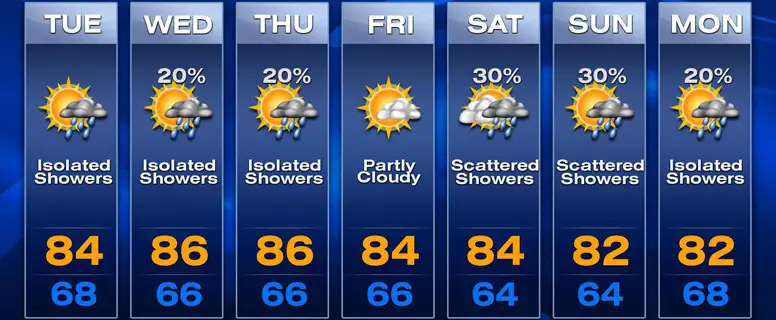
Trying to predict weather more than five days in advance is hard and can be inaccurate at times. Expecting a forecast to be accurate for 10 days is unrealistic and there are serious differences in forecast if one goes by this. They are basically more like guesses on the weather, as best can be made.
Even if there is bad weather, it most likely won’t last all day. Seeing storm icons on a weather forecast just means that it may or may not rain at some point during the day. Cloudy skies and rain all day long is an exception and abnormal in the Caribbean.
So why are thunderstorm forecasts so common then?
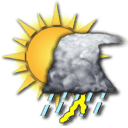 If you go by the continuous scattered thunderstorm forecast you’d think it rains constantly in the Caribbean. But this isn’t the case at all. Weather forecasts can be highly inaccurate in the Dominican Republic. One reason for this is that the weather services try and make one icon fit for an entire 24-hour day. It doesn’t go on to explain that Caribbean weather is so changeable.
If you go by the continuous scattered thunderstorm forecast you’d think it rains constantly in the Caribbean. But this isn’t the case at all. Weather forecasts can be highly inaccurate in the Dominican Republic. One reason for this is that the weather services try and make one icon fit for an entire 24-hour day. It doesn’t go on to explain that Caribbean weather is so changeable.
The sun can be out all day and then suddenly the sky darkens and an intense but short lived burst of rain comes in. Then nighttime is clear and breezy, with the temperature changing little more than a few degrees throughout the day. For general reference on weather conditions throughout the Dominican Republic see this Online Weather Forecast.
How cold is it in winter?
Weather changes are very slight season to season in DR. The average coastal temperature year round usually ranges from 25-34ºC (77-93ºF). Temps can be colder in the mountain peaks. The Cordillera Central mountain range in Valle Nuevo and Pico Duarte, for instance, can register below freezing. But even then the cities in the mountains like Jarabacoa and Constanza range from 18-28ºC (66-84ºF).
The south coast has much warmer temperatures than the north or northeastern coasts. Punta Cana-Bavaro can be very windy. Be sure to bring a sweater when visiting the mountain climes.
Bad weather – how common is it?
The chances of being caught in several days of rain during a week-long visit are slight. The best thing to do is check the weather satellite for tropical waves or storms in summer or for a cold front that could come in from the north in winter. A cold front may not necessarily bring rain but could bring cool temperatures of 20-25ºC (68-77ºF).
So how do you tell if a tropical wave or cold front is in the area?
The best resource is the Internet because there are many websites out there dedicated to weather.
Links:
Caribbean Satellite view (Wunderground)
Caribbean Satellite View (Weather Channel)
Tropical Weather Discussion (National Hurricane Center)
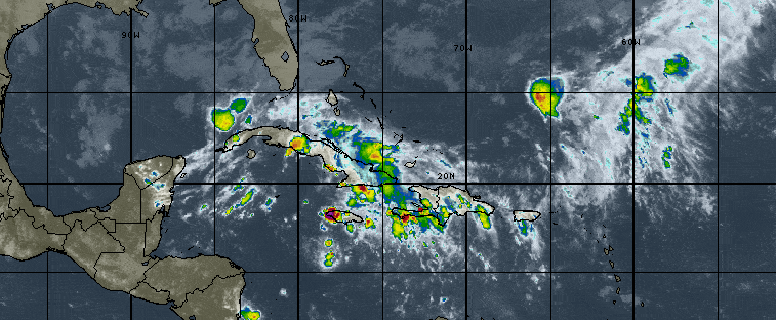
You can also ask weather related questions to our Facebook Community or follow us on twitter (@iHeart_DR) for updates in case of extreme weather warnings.
What’s the difference between a hurricane and a storm?
Tropical storms are classified into four different categories according to maximum wind speed and level of organization.
Tropical wave (disturbance): This is an unorganized mass of rain showers, with some thunder and lightning. Organized wind circulation is very little if any.
Tropical depression: These are numbered in order to facilitate information by the National Hurricane Center of Miami (The NHC). These systems show evidence of a closed wind circulation around a center has sustained winds of 23-39 mph (37-62kph).
Tropical storm: These are named in order to avoid confusion when one or more storms are being followed. A storm is given a name when winds reach strengths of 39-73 mph (63-118) kph.
Hurricane: This is a major storm occurring in the Atlantic with winds reaching over 73mph or 118 kph.
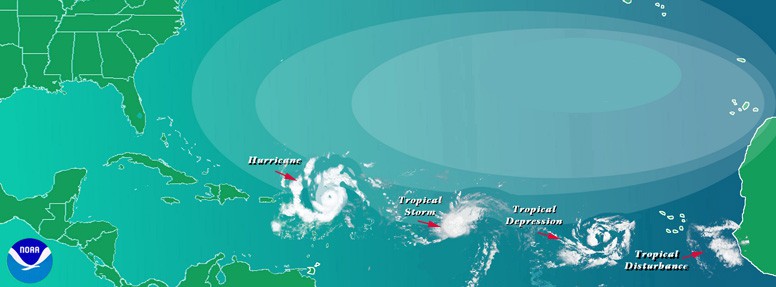
How to follow hurricanes in the Dominican Republic
iHeartDR has its own hurricane section that is updated often during hurricane season (which begins on June 1st). This page should answer most questions received at iHeartDR. It also provides more detailed information for those wanting to learn more about this type of phenomenon. When traveling to the area during hurricane season you may consider liking us on Facebook or following us on Twitter (@iHeart_DR) for regular updates on extreme weather conditions. You may also visit the iHeartDR questions sections to ask weather related questions to helpful locals.
Other great resources are:
The Wunderground Hurricane section
The Weather Channel’s Tropical section
[gap height=”15px”]
[ssboost]

